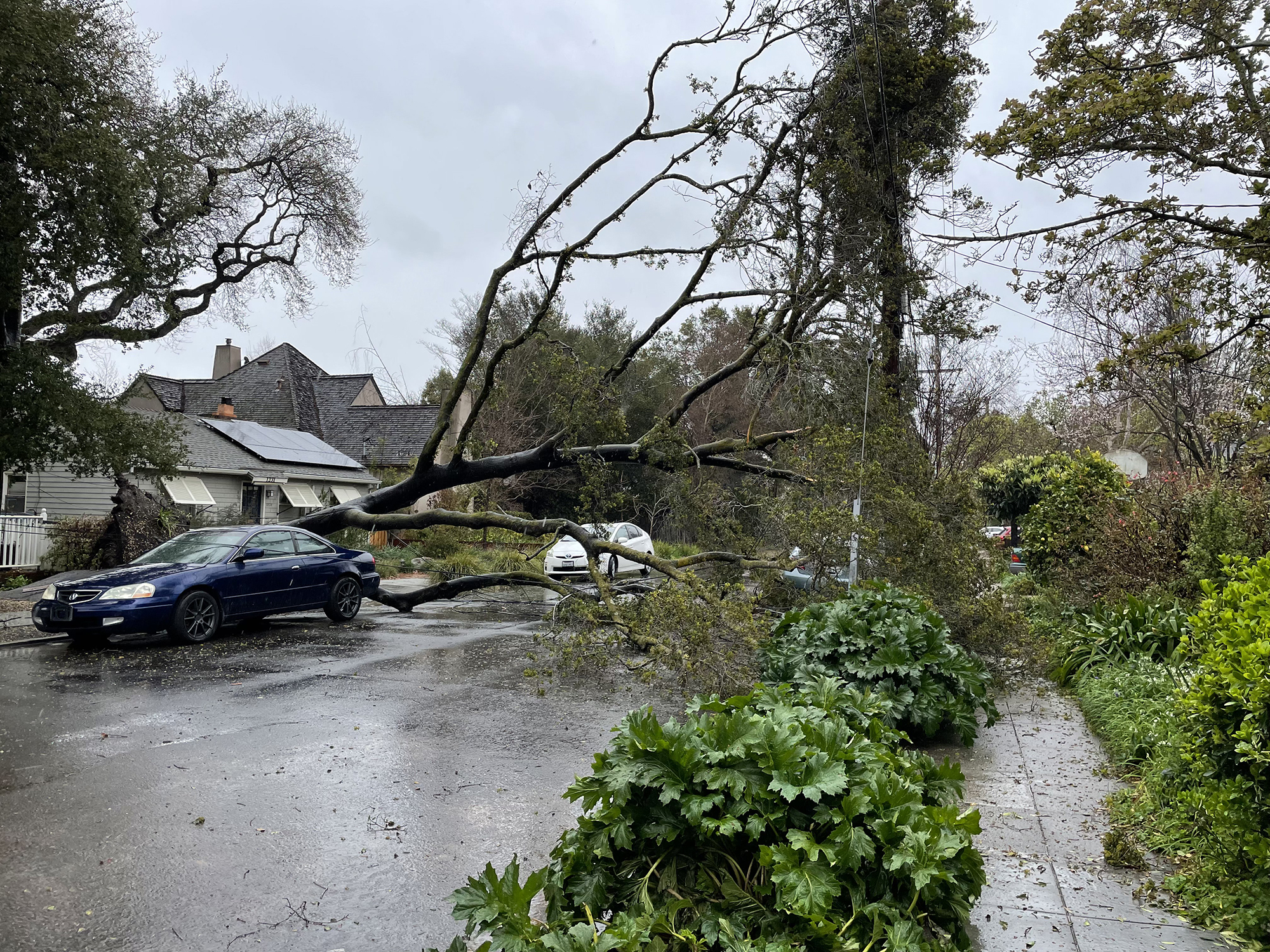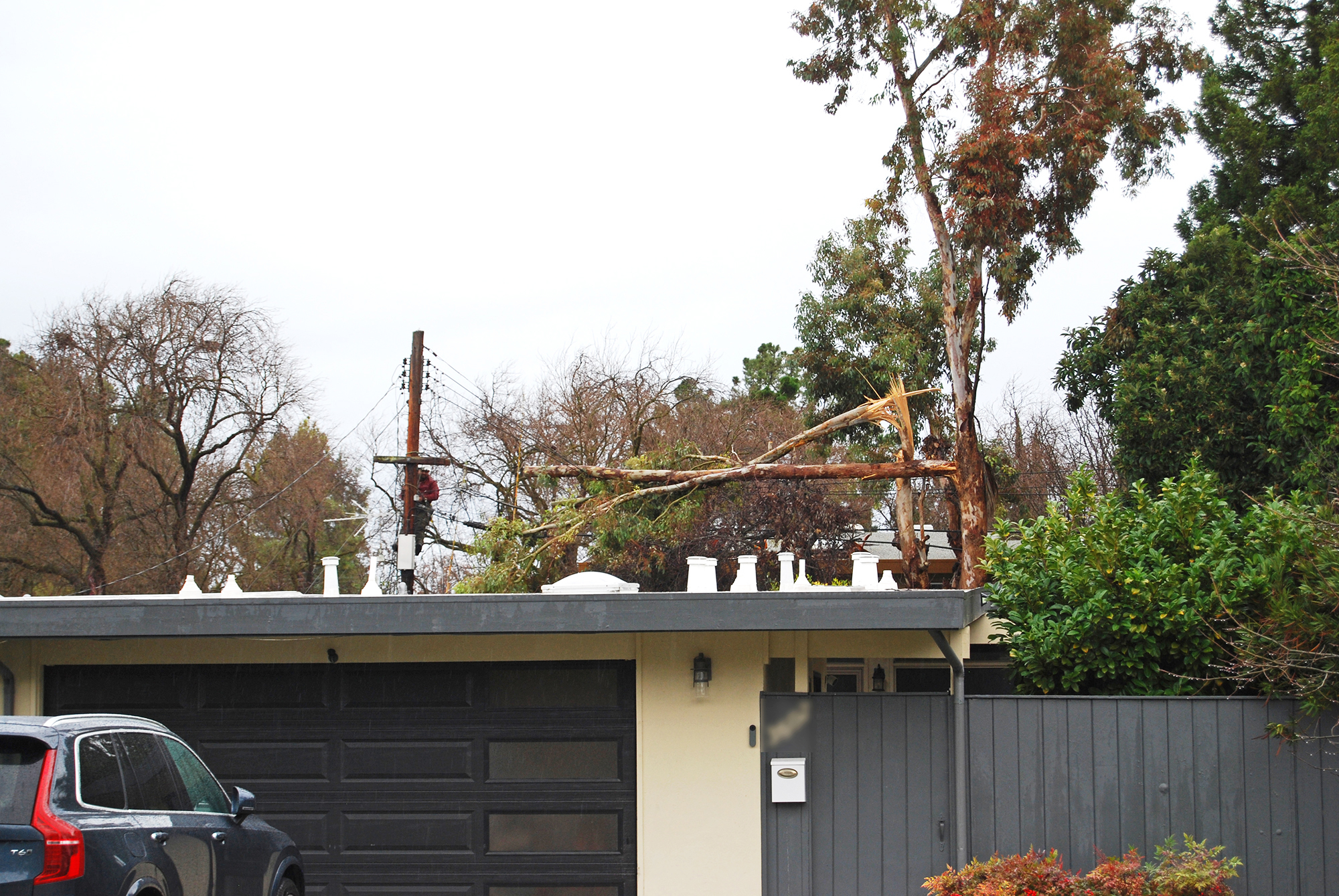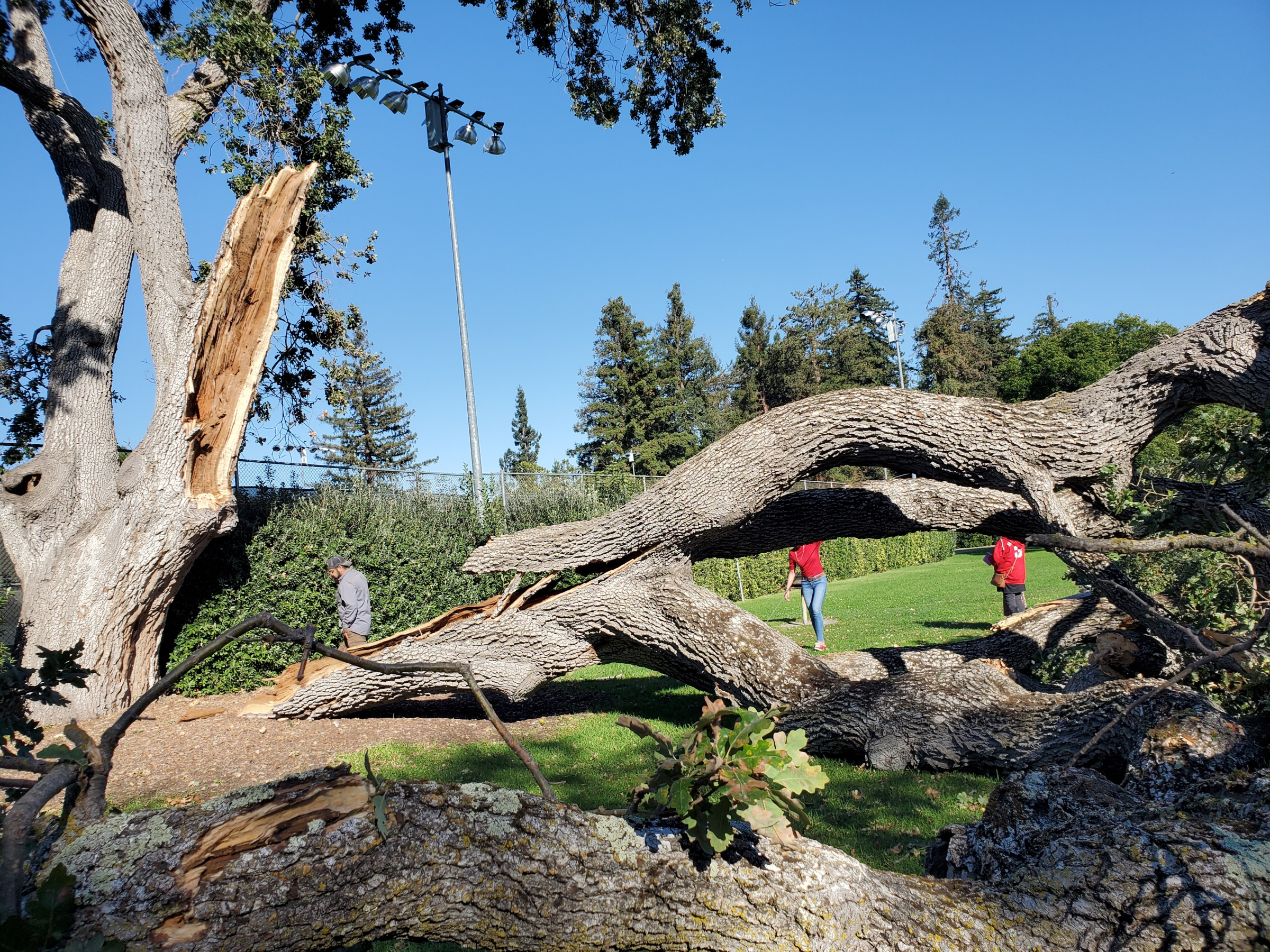When Palo Alto passed an ambitious tree-protection law in 2022, its aim was to shield the city's treasured canopy from destruction.
But after a year of heavy storms and scary episodes involving trees falling on top of homes and park visitors, the City Council on Tuesday, Jan. 16, took a step in the other direction. By a 5-2 vote, with City Council members Julie Lythcott-Haims and Greg Tanaka dissenting, the council modified the 2022 law to give property owners and developers more flexibility in removing trees.
The revisions seek to address some of the recently discovered flaws in the 2022 law, which roughly tripled the number of trees that are deemed "protected" and require a permit for removal. The law added four new tree species -- bigleaf maple, incense cedar, blue oak and California black oak -- to a protected roster that previously included only the coast live oak, the valley oak and the coast redwood. More significantly, trees of all species would be deemed protected if their diameter is 15 inches or greater (the only exception is the redwoods, which would have an 18-inch threshold).
The 2022 provisions increased the number of protected trees from 81,720 to 224,100, according to Peter Gollinger, the city's urban forester. Palo Alto has about 600,000 trees, which does not include its open space preserves.
But as city officials learned over the past year, people also need protection from trees. Numerous residents had trees fall on or next to their homes and one Barron Park homeowner had a giant branch from a toppling Douglas fir pierce her roof and damage her bedroom during a March storm. The resident, Leah Russin, had requested the city's permission to remove Douglas fir several months before the storm. Then, the new law kicked in, and permission was denied.
Even sunny weather is no guarantee that a tree won't topple on you, as resident Ben Lenail learned on Oct. 24 when an oak tree at Rinconada Park landed on him while he was out with his dog, Hazel (they were both caught up in the canopy and got out with some scrapes but no major injuries).
Russin urged the council to rethink the new law, which she argued represents a restrictive "command and control" approach. Rather than prohibiting tree removal, the city should give homeowners more latitude to remove trees on their properties and provide residents with incentives to plant new trees.
"We need flexibility; we need adaptation; we need mitigation," Russin told the council. "Preserving and locking in the landscaping decisions made by wildlife and people over a century ago are not going to protect us in the future."
But while Lythcott-Haims and Tanaka both supported Russin's position and recommended a broad overhaul of the tree-protection law, the council opted for only mild pruning. Much like the city's Parks and Recreation Commission and the Planning and Transportation Commission, which both reviewed the new law, the council agreed that the past year has been particularly wet and wild and that it would be premature to dramatically change the new law after just 18 months.
The changes they approved give the planning director more discretion to remove trees in development projects. Newly approved language also allows for tree removal in cases where a tree is at risk for "retrenchment" or does not conform to "right tree in the right place" principles, which pertain to a tree's location relative to utility facilities and other public infrastructure.
Gollinger said retrenchment occurs when a tree gets old and starts to "conserve resources."
"They bring their resources closer to their trunk. Sometimes they lose limbs," Gollinger told the council. "They can survive for a long time, but it's not necessarily a safe scenario in an urban environment. Out in the open space, it's fine, they can continue on for many, many years. But here in the urban environment, we want to prevent these limbs from failing."
The new law also allows removal if a tree represents a significant barrier to development, as determined by the 25% rule: The tree protection zone takes up 25% or more of the buildable lot.
But even if trees can be hazardous, the council majority generally agreed that that's a price worth paying for the joys they bring. While the Jan. 16 changes provide additional flexibility to homeowners for removing trees, most council members did not support any of the more sweeping proposals for revising the tree-protection ordinance.
Vice Mayor Ed Lauing made the case for retaining much of the new tree-protection law. He said he experienced the risk trees can pose first-hand during last winter's storm, when a giant branch from a redwood tree on a neighbor's property broke off and flew about 40 feet before landing on the second story of Lauing's house.
"That was pretty bizarre, but I wouldn't want him to take down his beautiful tree for that. To me, that's just a risk that you take," Lauing said. "Same thing as when you walk through the park.
"Trees fall and we can't predict all that. So we have to live with some of that uncertainty, and I don't know how we can legislate that."
Critics of the Tuesday revisions argued that these changes fail to fix some of the gaps that have recently been exposed in the tree ordinance. The law, for instance, requires confirmation from a certified arborist that a protected tree is failing before the city issues a permit to allow the removal. But even a certified arborist can have a hard time identifying a failing tree, as Russin found out when two different certified arborists told her that her Douglas fir seemed safe.
The oak at Rinconada also seemed fine, even to City Hall's top tree expert.
"From the ground there was no obvious issue," Gollinger told the council. "And once the tree fell, there was a flaw that was discovered where it broke. I don't think it's something that we could have anticipated unless we were up in the tree at that time to see it."
Tanaka suggested that the ordinance, even after revisions, fails to go far enough in boosting safety for residents, which he argued should be the council's top priority. Lythcott-Haims supported giving homeowners more power to remove trees but requiring them to plant two or three trees -- or contribute to a city fund dedicated to tree planting – to mitigate the removal.
"I'm worried that our ordinance binds property owners in a way that is too controlling and transfers risk in a way I'm not comfortable with," Lythcott-Haims said.
Others, however, argued that trees are a precious resource and that the city should do whatever it can to protect and grow its canopy. Jean-Paul Renaud, executive director of the nonprofit Canopy, was among those who supported the fairly limited changes that were brought forward by city staff and that had already been endorsed by the city's Parks and Recreation Commission and its Planning and Transportation Commission.
"We believe it would be premature and counterproductive to contemplate additional changes when this ordinance is still in its infancy," Renaud said.
Former Mayor Karen Holman, who had strongly advocated for the tree-protection ordinance, also supported giving the ordinance more time, notwithstanding the risks that naturally accompany having a world-class canopy.
"The only way to eliminate the possibility of a tree falling is to eliminate all the trees," Holman said. "Likewise, the only way to eliminate the possibility of car crashes is to take all the cars off the street.
"Neither is practical, and in fact, trees' very presence helps to mitigate the negative impacts of cars," she said.





Comments
Registered user
Crescent Park
on Jan 17, 2024 at 9:20 am
Registered user
on Jan 17, 2024 at 9:20 am
Thank you to the 5 on city council who supported the tree ordinance.
Julie Lythcott-Haims tried to deny she wrote in her own recent newsletter that the tree ordinance -
“…could be pitched as housing vs the environment…”.
Unlike the image she tries to project, JLH sows needless decisiveness while trying to mislead us about her attitude.
But it didn’t work.
It’s not a versus. Trees and housing do and will co-exist.
Registered user
Embarcadero Oaks/Leland
on Jan 17, 2024 at 10:34 am
Registered user
on Jan 17, 2024 at 10:34 am
Another thank you to the 5 who supported the tree ordinance which required a lot of work and thought and attention to detail -- something that JHL typically avoids. You can count on her to push for more housing and higher density as required by her deep-pocketed backers, most of whom are not even Palo Alto residents or individuals.
We deserve better leadership than one-trick ponies.
Registered user
another community
on Jan 17, 2024 at 11:49 am
Registered user
on Jan 17, 2024 at 11:49 am
The reporter here seems to imply that there were more than 2 public speakers who were against this item. This item was overwhelmingly supported by speakers. Additionally, Leah Russin never even applied for a tree removal permit! She was told the tree was Protected under the new ordinance and had 2 private arborists examine the tree. They did not recommend removal. She never applied to remove it. When the tree came down during the unprecedented storms, she put the blame on the City.
Registered user
Gunn High School
on Jan 17, 2024 at 12:20 pm
Registered user
on Jan 17, 2024 at 12:20 pm
I’d also like to think the five who supported the tree ordinance. Replacing one grand tree with two or three saplings is not equivalent in terms of the massive amount of carbon capture that the original tree represents. Nor is it equivalent, in terms of wildlife benefit.
Registered user
Stanford
on Jan 17, 2024 at 6:34 pm
Registered user
on Jan 17, 2024 at 6:34 pm
Trees add so much to the quality of life. Remember that terrible "clear cutting" on California Ave. and how bare and soulless the street looked afterward.
We are so fortunate to have beautiful trees in the community, and must do all we can to protect them.
Registered user
Palo Alto Hills
on Jan 19, 2024 at 10:33 pm
Registered user
on Jan 19, 2024 at 10:33 pm
I'm in the hills and we don't have the type of limits Palo Alto has for tree removal except for oaks. Some of the trees here grow completely out of control. In the urban areas of Palo Alto I can understand the desire to protect trees but up in the hills, some of the trees grow like crazy and new ones are sprouting up all the time.
They grow into power lines, water mains, they become fire and fall hazards. Many of the trees can't be seen by anyone except the home owner themselves. If you look at images and maps of the area a hundred years ago, there were none of these trees in most of the area. For example, take a walk around Arastradero Preserve, that's what it looked like. Rancho San Antonio has more tress but the areas with homes have the most trees because they are not here naturally.
The Eucalyptus are really problematic because they will grow multiple feet in a year until they are huge, they are big fire risks and constantly shedding. There needs to be a good balance between reasonable tree removal and the desire to protect all trees. In the hills, there are a number of areas with just too many trees as it is and they aren't here naturally. I don't think more trees need to be on a protected list and think homeowners who want to remove trees should be given more options to do so when they aren't natural to the area.